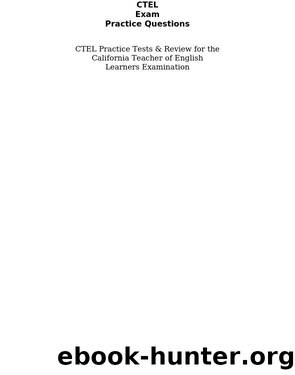CTEL Exam Practice Questions by CTEL Exam Secrets Test Prep Staff

Author:CTEL Exam Secrets Test Prep Staff
Language: eng
Format: epub
Publisher: Mometrix Media LLC
c. morphology.
d. B and C.
15. An English language learner (ELL) student is able to determine that the word bear means to carry rather than a big animal because it is used as a verb and has an object of burden in a sentence. This is an example of which vocabulary and semantics strategy?
a. Apposition
b. Context clues
c. Word structure
d. Prior L1 knowledge
16. Which of the following is accurate regarding the California State Board of Education Adopted Reading/Language Arts-English-Language Development (RLA/ELD) Programs?
a. Not all of them are aligned with standards.
b. All of these programs are Basic programs.
c. All are Intensive Intervention programs.
d. Not all of them target English learners.
17. An English language learner (ELL) student says, âI will come for your house.â What is this error regarding?
a. Adjectives
b. Prepositions
c. Conjunctions
d. Indirect objects
18. A class of advanced-level, high school English language learner (ELL) students is analyzing a piece of text their teacher has given them that uses a highly convoluted writing style filled with long, compound-complex sentences containing multiple clauses, modifiers nested within modifiers, and so on. While the text described involves all four of the following, which one does the description refer to MOST specifically?
a. Writing style
b. Level of difficulty
c. Complexity of syntax
d. Featured language structures
19. In the scoring rubric for the Short Compositions item on the Grades 2 through 12 Writing test of the California English Language Development Tests (ELDTs), which of the following is one criterion included for assigning a score of 4âFully Competent Communication?
a. The response contains well-organized ideas and events, a few effective details, and transitional devices.
b. The response has logical sequencing and is mostly recognizable and comprehensible as a paragraph.
c. The response has correct subject and predicate word order in at least one complete or run-on sentence.
d. At least one word (not a, I, or the) is spelled correctly, and the subject and predicate is recognizable.
20. Of the following, which have research studies found about how English language learners (ELLs) apply pragmatics knowledge socially?
a. They more often interpret othersâ speech literally than infer meaning from the context.
b. They tend to use politeness markers more in English than they typically would in their L1.
c. They tend to be more sensitive to context in choosing pragmatic strategies in L2 than L1.
d. They are more likely to exaggerate context factors of social power and distance in English.
21. A teacher evaluates the California English Language Development Tests (CELDTs) for addressing areas of phonology and morphology. On these tests, which question does the teacher identify as MOST addressing phonological production?
a. Choose and give reasons
b. Short compositions
c. Speech functions
d. Copying letters
22. A teacher gives English language learning (ELL) students three sentences: âShe knew what to do.â âShe knew what not to do.â âShe knew not what to do.â Student 1 thinks these all have the same meaning. Student 2 notices that the second and third sentences contain a negative that the first sentence does not but thinks the second and third sentences mean the same thing. Student 3 correctly says they all have different meanings.
Download
This site does not store any files on its server. We only index and link to content provided by other sites. Please contact the content providers to delete copyright contents if any and email us, we'll remove relevant links or contents immediately.
1,001 ASVAB Practice Questions For Dummies by Powers Rod(4071)
ASVAB For Dummies by Powers Rod(2476)
Police Exams Prep 2018-2019 by Kaplan Test Prep(2059)
Churchill by Paul Johnson(2034)
Wonder by R J Palacio(1634)
Wiley CPA Examination Review Focus Notes by Kevin Stevens(1630)
First Aid Handbook--Crucial Survival Skills, Emergency Procedures & Lifesaving Medical Information by Department of the Army(1522)
1936941139 (N) by Bob Rosenthal(1520)
A Very Stable Genius by Philip Rucker & Carol Leonnig(1354)
ASVAB AFQT For Dummies by Rod Powers(1334)
1,001 ASVAB AFQT Practice Questions For Dummies by Angie Papple Johnston(1195)
U.S. Army Combat Pistol Training Handbook by Army(1170)
CISSP For Dummies by Miller Gregory Peter(1154)
The GED Crash Course by Alpha(1128)
Court Officer Exam by Learning Express LLC(1080)
McGraw-Hill Education 2,000 Review Questions for the CPA Exam by Denise M. Stefano(1079)
Master the Civil Service Exams by Peterson's(1075)
Master the ASVAB by Scott Ostrow(1066)
Future Design by Unknown(1041)
